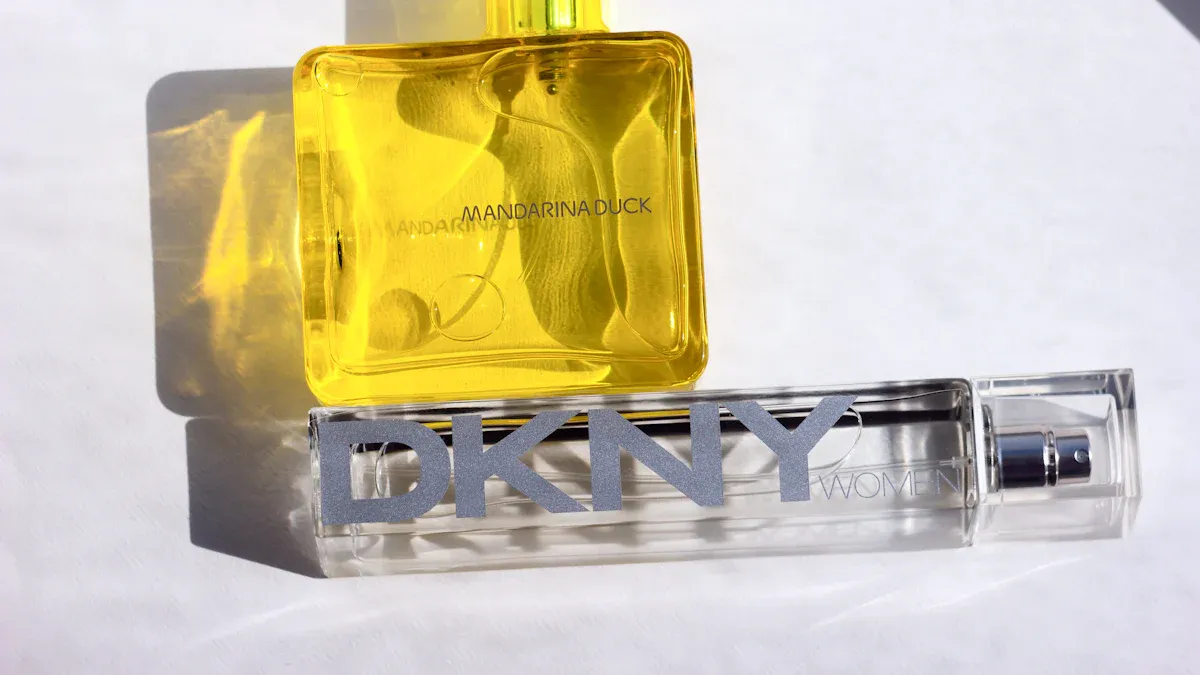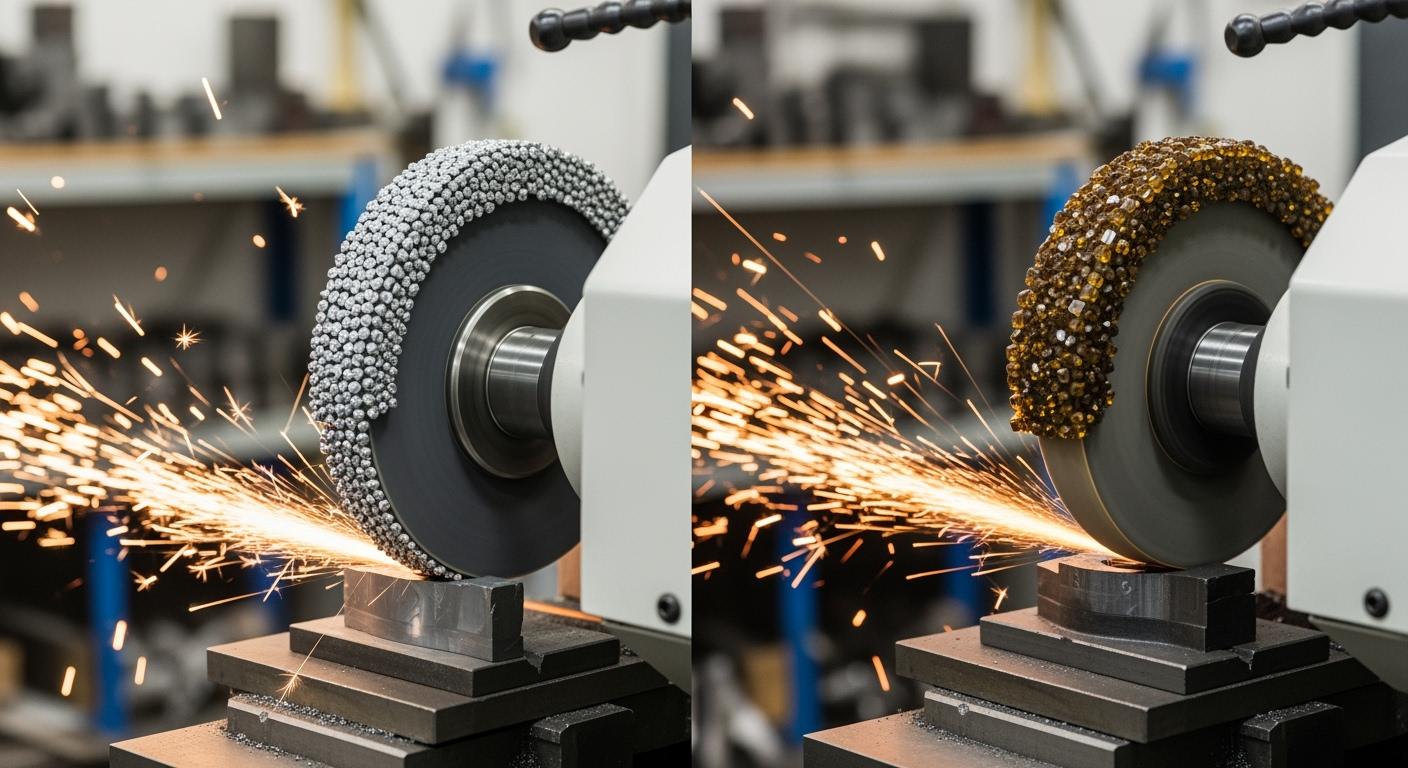The core difference between a diamond and cbn grinding wheel is simple. Diamond wheels are for non-ferrous materials. CBN grinding wheels are for ferrous metals. This diamond vs cbn rule is due to a chemical reaction. High heat makes the carbon in diamond react with steel’s iron, which destroys diamond wheels. This makes cbn the choice for steel. Selecting the right superabrasives is key. A diamond superabrasive wheel excels on carbide, while cbn grinding wheels are unmatched on steel. Correctly choosing between diamond wheels and cbn grinding wheels ensures quality.
Key Takeaways
- Diamond wheels work best for materials without iron, like ceramics or glass. They are very hard.
- CBN wheels are for metals that contain iron, such as steel. They do not react with iron.
- Diamond wheels cannot grind steel because heat makes them break down. The diamond reacts with the steel.
- Choosing the right wheel helps you grind materials faster and get a better finish. It also saves money over time.
Material application: The deciding factor
Choosing the correct superabrasive wheel depends entirely on the material you need to grind. The fundamental difference between a diamond and cbn grinding wheel dictates its use. One excels where the other fails completely. This section explains the “why” behind each wheel’s specific application.
Applications for diamond wheels
Diamond wheels are the ultimate solution for grinding extremely hard and brittle materials. Their unmatched hardness allows them to shape substances that other abrasives cannot handle effectively. Operators use diamond wheels for non-ferrous materials that lack iron.
Common applications include:
- Tungsten Carbide: This material is extremely hard. Industries use it for high-performance cutting tools, drills, and dies. Diamond wheels are essential for shaping and sharpening these carbide cutting tools.
- Advanced Ceramics: Technical ceramics like Zirconia and Alumina are used in demanding fields. Zirconia is common in medical and dental implants. Alumina is used for electronic components. Diamond wheels provide the precision needed to machine these parts after firing.
- Glass and Stone: Diamond wheels deliver clean, chip-free cuts on glass for optical lenses and architecture. They also efficiently cut and finish natural stone like granite.
- Composites: Modern composites found in aerospace and automotive parts require the precision of diamond wheels for finishing.
These applications often involve manufacturing high-value components. This includes aerospace parts, precision cutting tools, and medical instruments. The right diamond wheels ensure tight tolerances and superior finishes on these critical items.
The problem with diamond on steel
Using diamond wheels on steel or other ferrous metals is a costly mistake. The problem is a chemical reaction caused by heat. Grinding generates intense friction and high temperatures. When the heat reaches approximately 700 K (about 427°C), a destructive process begins.
The carbon atoms in the diamond abrasive react with the iron atoms in the steel. This reaction causes the diamond to dissolve into the workpiece, a process known as chemical wear. The diamond wheel rapidly erodes and loses its cutting ability.
This chemical breakdown makes diamond wheels highly inefficient for grinding steel. The wheel wears down so quickly that it cannot perform its job, leading to wasted time and resources. This is why a different superabrasive is necessary for ferrous metals.
Applications for cbn grinding wheels
Cubic Boron Nitride (CBN) is the perfect abrasive for ferrous metals. CBN grinding wheels solve the chemical reaction problem seen with diamond. CBN is chemically inert when grinding iron-based materials. It does not react with iron, even at the high temperatures generated during grinding. This stability makes cbn grinding wheels the only logical choice for hardened steels.
CBN grinding wheels are ideal for materials such as:
- High-Speed Steel (HSS)
- Hardened Tool Steels (like D2)
- Hardened Stainless Steels
- Bearing and Alloy Steels
- Hardened Cast Iron
- Superalloys (Iron or cobalt-based)
Industries rely on cbn grinding wheels for manufacturing critical components. Automotive companies use them for powertrain and bearing components. Aerospace manufacturers use them for high-stress turbine parts. Toolmakers depend on cbn grinding wheels to create and sharpen precision cutting tools from hardened steel. For any application involving hard ferrous metals, cbn grinding wheels deliver superior performance and wheel life.
Aimgrind’s high-performance diamond solutions
For applications involving hard, non-ferrous materials, the quality of the diamond grinding wheel is paramount. Aimgrind specializes in providing customized diamond wheels designed for these demanding tasks. With extensive experience, Aimgrind develops personalized formulas to perfectly match the wheel to the material, whether it’s tungsten carbide for cutting tools or advanced ceramics for electronics. This expertise ensures that operators can achieve maximum efficiency and precision. Choosing a high-performance diamond wheel from a specialized provider like Aimgrind is key to producing top-quality cutting tools and components.
Key properties: Diamond vs CBN

Understanding the material application rule requires a look at the core properties of each superabrasive. The physical and chemical characteristics of diamond and CBN directly influence their performance. This diamond vs cbn performance comparison reveals why one is suited for steel and the other is not.
Comparing hardness and thermal stability
At room temperature, diamond is the hardest known material. It has a Knoop hardness of about 7,500, while CBN measures around 4,500. This superior hardness makes diamond wheels excellent for grinding hard, non-metallic materials. However, this advantage disappears under the intense heat of grinding.
Heat is a critical factor. Diamond begins to break down and lose its hardness at temperatures around 700°C. In contrast, CBN has far greater thermal stability. It remains stable at temperatures over 1000°C. Remarkably, CBN actually becomes harder than diamond at temperatures exceeding 800°C. This thermal resistance makes cbn grinding wheels ideal for the high-heat environment of steel grinding, where diamond wheels would quickly fail.
Chemical reactivity with metals
The most significant difference is how each abrasive reacts with iron. Scientific studies show that at high temperatures, the carbon atoms in a diamond abrasive react with the iron in steel. This chemical reaction transforms the diamond into graphite, causing the diamond wheels to wear down extremely fast. This makes using diamond wheels on ferrous metals inefficient and costly.
CBN, on the other hand, is chemically inert when grinding ferrous metals. It is composed of boron and nitrogen atoms, which do not react with iron. This stability offers several key advantages for cbn grinding wheels:
- It prevents the rapid chemical wear that affects diamond.
- It leads to a much longer and more predictable life for cbn grinding wheels when working with steel.
- It helps produce a cleaner cut and a superior surface finish on the workpiece.
Abrasive particle shape and grit
The choice of abrasive grit size also impacts performance for any diamond and cbn grinding wheel. Operators select grit size based on the job’s requirements.
| Property | Diamond | CBN |
|---|---|---|
| Hardness (Room Temp) | Hardest material (~7,500 Knoop) | Second hardest (~4,500 Knoop) |
| Thermal Stability | Degrades around 700°C | Stable over 1000°C |
| Reactivity with Iron | High (Reacts and dissolves) | Inert (Does not react) |
Larger abrasive grains allow for faster material removal, improving efficiency for rough grinding tasks with both diamond wheels and cbn grinding wheels. For tasks requiring a smooth, precise surface, operators use smaller grit sizes. This principle applies to both diamond wheels and cbn grinding wheels, allowing for customization based on the desired outcome.
Performance, cost, and finish
The choice between a diamond and cbn grinding wheel directly affects practical outcomes. This performance comparison highlights how selecting the right wheel impacts grinding efficiency, long-term costs, and final part quality. Making the correct choice is essential for any successful grinding operation.
Impact on grinding efficiency
Using the correct wheel significantly boosts grinding efficiency. For example, an Aimgrind diamond grinding wheel on tungsten carbide allows for faster material removal with lower grinding forces. This improved grinding efficiency reduces cycle times and minimizes stress on the machine. Operators can work faster without sacrificing precision. The right superabrasive grinding wheels make the entire process smoother and more productive. This boost to grinding efficiency is a key benefit.
Long-term value and wheel life
Superabrasive wheels have a higher initial cost. However, their long-term value is excellent. The longevity of diamond wheels and cbn grinding wheels reduces the need for frequent replacements. This leads to less machine downtime. Reduced downtime saves money on labor and increases throughput. A real-world example showed that a 15% longer wheel life saved a company about $12,000 annually. The return on investment (ROI) for superabrasive wheels is high when considering all factors.
ROI = (Gain from Investment – Cost of Investment) / Cost of Investment × 100
The “gain” includes time saved and increased productivity, while the “cost” includes labor and waste. This makes diamond wheels a cost-effective investment over time.
Achieving a superior surface finish
The right wheel is crucial for a high-quality surface finish. It helps maintain the integrity of the part by preventing thermal damage, also known as grinding burn. Using the wrong wheel generates excessive heat, which can ruin the workpiece.
- Fine-grit diamond wheels can achieve a very smooth finish on ceramics, with a surface roughness (Ra) between 0.2-0.8 μm.
- CBN wheels can produce an even finer finish on hardened steel, with Ra values often below 0.1 μm for superfinishing.
Choosing the correct diamond or cbn abrasive ensures the part meets specifications without defects.
The choice between a diamond and cbn grinding wheel follows one simple rule. Diamond wheels excel on non-ferrous materials like ceramics and glass. CBN grinding wheels are for ferrous metals like steel. This distinction is based on fundamental differences in chemical reactivity and thermal stability. Choosing the correct diamond wheels or cbn grinding wheels is vital for industries from automotive to aerospace. To maximize productivity, partner with a specialist like Aimgrind for help selecting the perfect diamond wheels or cbn grinding wheels.
FAQ
What is the main rule for choosing between diamond and CBN?
Operators should follow a simple rule. Use a diamond wheel for non-ferrous materials like carbide and ceramic. A CBN wheel is the correct choice for ferrous metals like steel and cast iron. This ensures the best performance.
Why can’t diamond wheels grind steel?
High heat from grinding causes a chemical reaction. The carbon in the diamond abrasive dissolves into the iron of the steel workpiece. This reaction quickly destroys the diamond wheel, making it ineffective for grinding steel.
Which wheel is better for sharpening steel cutting tools?
A CBN wheel is the only choice for sharpening steel cutting tools. CBN does not react with the iron in steel. This stability provides a long wheel life and a precise finish on hardened steel tools.
Is diamond harder than CBN?
At room temperature, diamond is the hardest material. However, CBN has better thermal stability. It stays hard at the high temperatures of steel grinding. Diamond loses its hardness and breaks down under that same heat.
Contact Us
For More Grinding Solution or Customized Abrasive Tools

